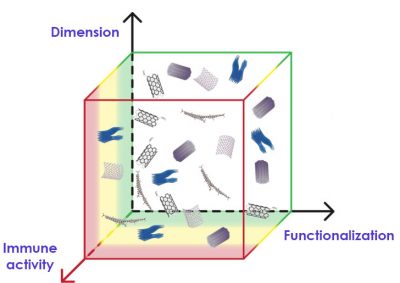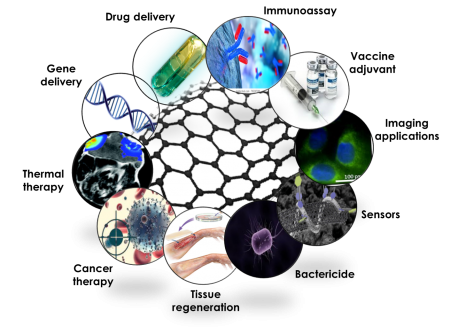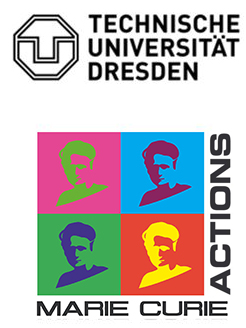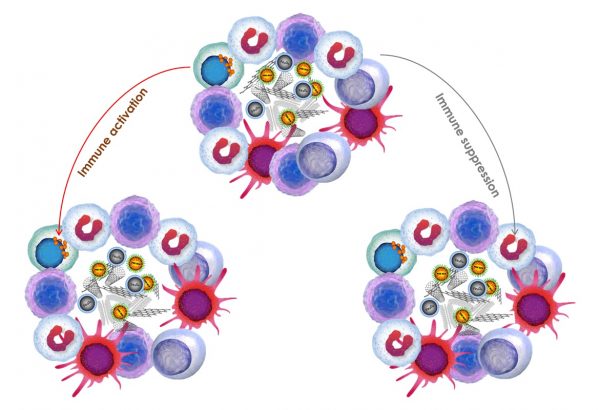MEDICINE
INTRODUCTION TO LUCIA DELOGU’S CONCEPT: NANOIMMUNITY-BY-DESIGN

Our research relies mainly on the translation of different nanomaterials (NMs) in the medical scenario. In collaboration with international leaders in nanomaterial synthesis and chemical characterization, our laboratory focuses on carbon-based materials (CBMs), such as: graphene, aminated graphene, graphene oxide, graphene nanoribbons, and carbon nanotube fibers. The PI Lucia Gemma Delogu obtained as scientific coordinator two European projects: the G-IMMUNOMICS, partnering project of the European Graphene Flagship, and Carbo-IMMAP financed under HORIZON 2020.
My novel concept “NanoImmunity-by-design” (Gazzi et al. J. Phys. Mater, 2020), where the production and use of NMs are not solely based on physicochemical properties but also shaped by their predictable immune properties, aims to shape the future field of nanosafety. Going far beyond the state of the art, I revealed for the first time the echogenic properties of functionalized carbon nanotubes (Delogu et al., PNAS 2012 IF>9), this work become a seminal paper in the context of theranostic applications based on ultrasonography. I also was the first to propose their use as immunomodulatory systems (Pescatori M et al., Biomaterials 2013 IF>10) representing a cutting-edge study for the exploration of amino-functionalized carbon materials in the context of immunotherapy and later on for space biology applications (Crescio C et al., Nanoscale 2014 IF>7), my efforts and preliminary data lead to the new section “Space biology” within the Graphene scientific community. More recently, I provided new insights for nano-based cancer treatment, demonstrating, by an innovative approach in single-cell mass cytometry, that certain types of graphene can trigger a T-helper 1 immune response, which is critical for the induction of immune-mediated tumor regression (Orecchioni M et al., Nat. Comm. 2017 IF>12, Orecchioni M et al. Small 2020 IF>10). Moreover, I proposed few-layer graphene potential therapeutic applications for myelomonocytic leukemia (Russier R et al., Angew. Chem. 2017 IF>12).
GRAPHENE AND 2D MATERIALS IN IMMUNOLOGY

Graphene is the most promising, versatile, and sustainable key enabling nanotechnology which may bring solutions in the near future to many areas spanning materials science and medicine. A critical step for future translational applications of graphene is represented by the assessment of its impact on the immune system (Orecchioni M et al. Nature Communications 2017, Orecchioni M et al. Adv Health Care Mat 2016).

The PI Lucia Gemma Delogu is currently on leaving as visiting scientist at Technische Universität Dresden (TUD) thanks to a Marie Curie Individual Fellow Horizon 2020 (IMM-GNRs project, host: Prof. Xiliang Feng). Within this context, our laboratory is going to study graphene nanoribbons (GNRs). GNRs are finite sized graphene materials with confined widths. In contrast to other carbon nanomaterials, such as graphene oxide, GNRs via the bottom-up organic synthesis will provide key novel aspects: i) the perfect control of structure at the atomic level, ensuring higher reproducibility; ii) the possible conjugation with polar PEG-side chains, allowing very stable dispersion in water; iii) the tailoring with different molecules and drugs, opening fascinating perspectives in healthcare. All these advantages compared to other NMs make them “gold” carbon tools for their development in a medical direction. In the next future, our team is going to show the immune activity of differently functionalized GNRs designed for biomedical applications.
IMMUNE PORTFOLIO OF OTHER NANOMATERIALS

The research group is exploring carbon and non-carbon-based materials, selecting them on the basis not only of their suitable chemical and physical characteristics but also of their bio- and immune-compatibility. The goal is to boost the acceptance of the “Immune by design” concept in a broad spectrum of nanomaterials (Farace C et al Scientific Report 2016, Dolci S RSC ADV 2016, Al Soubaihi et al. Colloids Surf B Biointerfaces. 2018, Toma et al. Biomacromolecules 2018). We are currently working with nanodiamonds, carbon fibers, carbon dots, and several others nanomaterials, in collaboration with the best key scientific leaders at world level in nanotechnology.
